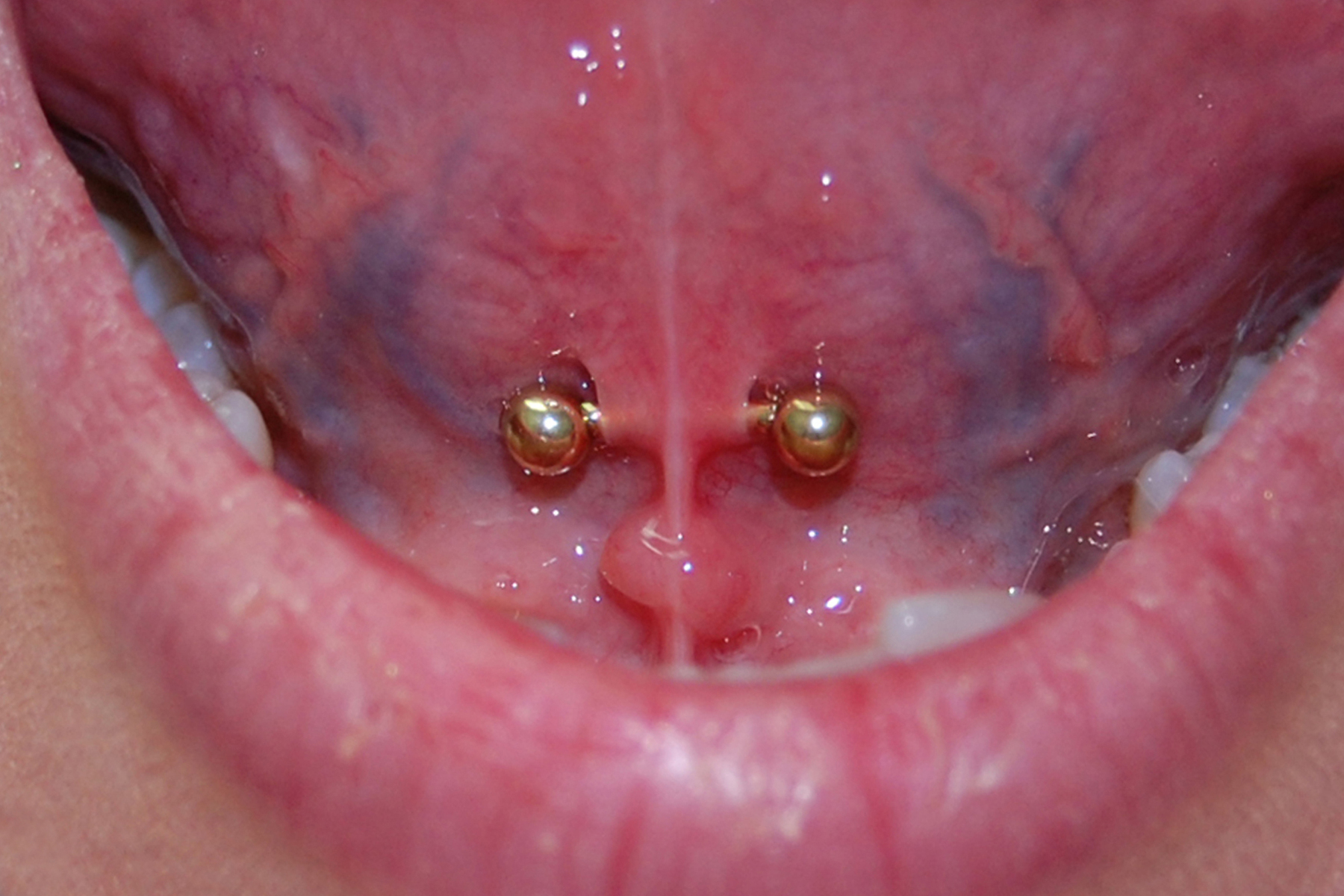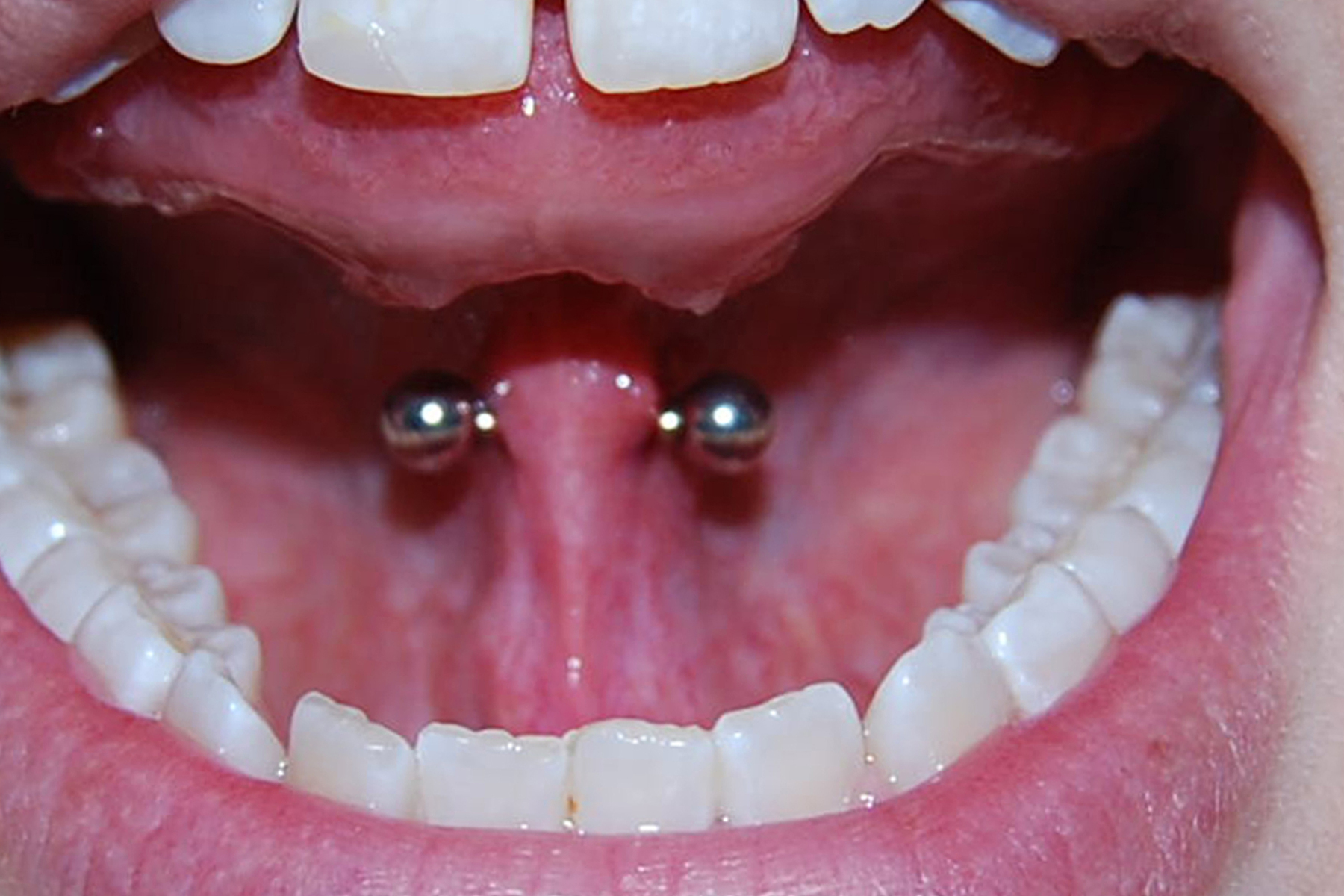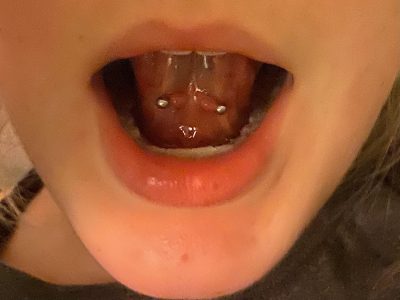In a world of increasingly visible and bold body art, there is a unique allure to a piercing that is kept hidden—a personal secret, a subtle flash of metal revealed only when the wearer chooses. The tongue web piercing, known anatomically as the lingual frenulum piercing, is the epitome of this discreet charm. Nestled in the thin membrane connecting the underside of the tongue to the floor of the mouth, it is a true “hidden gem” of the piercing world, a subtle statement for those who appreciate a more intimate form of self-expression.
However, the delicate and hidden nature of this piercing should not be mistaken for simplicity. Its location, surrounded by vital oral structures, means that safety, precision, and a deep understanding of anatomy are not just important—they are paramount. At PinkTatPier, we approach this seemingly simple piercing with the same meticulous care and expertise as our most complex facial projects. We recently had a consultation with a client, Clara, who works in a very corporate environment in the City but has a deep love for body art. She wanted a piercing that was “just for her,” something that wouldn’t impact her professional life. She was intrigued by the tongue web piercing London but was understandably worried about the risks she had read about online, particularly concerning damage to glands or teeth.
Our lead specialist spent the consultation not just talking, but educating. They used an anatomical diagram to show Clara the exact location of the lingual frenulum, and then, more importantly, pointed out the nearby submandibular salivary ducts. They explained that the entire success of the piercing hinged on assessing her frenulum’s size and thickness to ensure it could safely support jewellery away from these vital structures. After a careful in-person assessment confirmed that Clara’s anatomy was ideal—with a pronounced and healthy frenulum—we were able to discuss jewellery choices, opting for a small, snug curved barbell to minimise any potential tooth contact. Clara left her appointment not just with a beautiful, hidden piercing, but with the profound confidence that it had been performed with the highest possible standard of care.
This story is the foundation of our professional service. This guide is an extension of that educational, safety-first consultation. It is the definitive resource for anyone considering a tongue web piercing London, designed to give you all the information you need to make a safe, informed decision and book online with confidence.

tongue web piercing
Anatomy of a Hidden Gem: Defining the Frenulum Piercing
Before considering this piercing, it’s crucial to understand the very specific and delicate anatomy involved.
The Definition: Piercing the Lingual Frenulum
The “tongue web” is the common name for the lingual frenulum. This is the thin, web-like membrane of tissue that connects the underside of your tongue to the floor of your mouth. You can easily see it if you lift your tongue towards the roof of your mouth in a mirror. The piercing passes horizontally through this thin strip of tissue. When done correctly, it is a very quick and relatively low-pain procedure.
The Critical Anatomical Assessment: Is Your Frenulum Suitable?
This is the most important part of the process, and where the eye of a true specialist is essential. Not everyone is a suitable candidate for a tongue web piercing. The success and safety of this piercing are entirely dependent on the size, thickness, and structure of your individual frenulum.
- A Pronounced Frenulum: For the piercing to be viable, your frenulum must be substantial and well-defined. If the membrane is too thin, too small, or too tight (a condition sometimes known as being “tongue-tied,” or ankyloglossia), it cannot safely support jewellery and will be prone to tearing or rejection.
- Proximity to Salivary Ducts: On either side of the base of the frenulum lie the openings for the submandibular ducts (Wharton’s ducts). These are vital glands responsible for a significant portion of your saliva production. An inexperienced or careless piercer could potentially damage these ducts. A specialist at PinkTatPier is trained to precisely identify these structures and ensure the piercing is placed safely in the central tissue of the frenulum, well away from them.
- Vascularity: The area is rich in blood vessels. Our specialists will visually assess the area for any large, visible veins running through the frenulum itself to choose the safest possible placement and minimise bleeding.
Our Studio’s Philosophy on Oral Piercings:
“The mouth is a complex environment, and any piercing within it demands an exceptional level of anatomical knowledge. The tongue web is a delicate structure. Before we even consider picking up a needle, we perform a thorough assessment. We’re looking for a pronounced, healthy frenulum with enough tissue to support jewellery away from the salivary ducts. Our first job is to confirm viability. If the anatomy isn’t there, the answer, for the client’s safety, has to be ‘no’. For a piercing this close to vital oral structures, safety is the only thing that matters, and that is the core of our professional service.” – Our Lead Specialist at PinkTatPier
The Piercing Process & Jewellery Options: A Specialist’s Approach
If your anatomy is deemed suitable, the procedure itself is one of the quickest and simplest to perform, provided it is done by an expert.
The Technique: A Swift and Gentle Approach
The process at our London studio is designed for safety and comfort.
- Preparation: You will be asked to rinse with an antiseptic, alcohol-free mouthwash.
- Marking: The area will be carefully dried, and your specialist will mark the precise entry and exit points on the frenulum.
- The Piercing: The frenulum is held steady (often with sterile gauze, not always clamps), and a single-use, hollow, sterilised needle passes through in one quick, fluid motion. The entire sensation lasts for only a moment.
- Jewellery Insertion: The pre-sterilised, internally threaded jewellery is then inserted, and the ends are secured.

tongue web piercing
Jewellery is Key to Long-Term Safety: Curved Barbells vs. Rings
The type and size of the jewellery used for your tongue web piercing London are critical for both initial healing and long-term oral health.
- Curved Barbell (Highly Recommended): For almost all initial tongue web piercings, we exclusively recommend and use a small, implant-grade titanium curved barbell. The gentle curve allows the jewellery to sit more naturally with the shape of the mouth, reducing pressure on the piercing. Furthermore, the small, smooth beads are significantly less likely to make consistent, damaging contact with the back of your lower teeth or cause gum erosion.
- Captive Bead Ring (CBR) or Hoop: While some clients desire the look of a ring, it is generally not recommended for initial healing. A ring has more movement, which can prolong healing, and its larger diameter means it has a much higher chance of constantly rubbing against the sensitive lingual surface of your teeth and your gum line. This is an option that can be explored after the piercing is fully healed, and only if a very small, perfectly fitted ring can be used without causing oral contact.
The Healing Journey & Aftercare: A Surprisingly Fast Process
One of the most appealing aspects of the tongue web piercing is its remarkably fast healing time, thanks to the highly vascular nature of the tissue in the mouth.
The Healing Timeline: What to Expect
With proper care, the frenulum is one of the fastest-healing piercings. The table below outlines a typical healing journey.
Table: Tongue Web Piercing Healing Guide & Aftercare
| Timescale | What to Expect | Key Aftercare Actions |
| Day 1-7 | Mild swelling, some tenderness, and a “foreign” sensation in the mouth are normal. You may experience some initial difficulty with certain speech sounds (a slight lisp). | Rinse your mouth with an alcohol-free antimicrobial mouthwash after every time you eat, drink, or smoke, and once in the morning and once at night. Avoid overly spicy, acidic, and crunchy foods that could irritate the area. |
| Week 2-4 | The initial swelling and tenderness should completely subside. The piercing will start to feel much more comfortable and natural in your mouth. | Continue with your diligent oral hygiene routine. Be mindful not to “play” with the jewellery with your tongue, as this can cause irritation and damage to your teeth. |
| Week 4-8 | For most people, the piercing is likely fully healed if aftercare has been consistent and there have been no complications. | Book a check-up with your piercer. We can confirm that the piercing is fully healed and discuss downsizing the initial barbell to a snugger, safer fit for long-term wear. |
Long-Term Risks and How to Mitigate Them
Even after it’s healed, a safe tongue web piercing requires mindful long-term care.
- Plaque and Tartar Buildup: Like your teeth, jewellery in the mouth can accumulate plaque. When you brush your teeth, gently brush your jewellery as well with a soft-bristled toothbrush.
- Gum and Tooth Damage: This remains the primary long-term risk. It is caused by the jewellery constantly rubbing against your teeth or gums. This risk is minimised by:
- Correct Placement: Ensuring the piercing is placed properly by a specialist from day one.
- Appropriate Jewellery: Using a small, snug-fitting curved barbell.
- Regular Dental Check-ups: Your dentist can be your best partner in monitoring the health of your teeth and gums.
Booking Your Safe Piercing in London
Choosing a professional studio is the single most important decision you will make for this piercing.

tongue web piercing
Why Choose a Specialist at PinkTatPier?
Our reputation is built on an unwavering commitment to safety and expertise. When you choose us for your tongue web piercing London, you are choosing:
- Unmatched Anatomical Knowledge: Our specialists have the training and experience to assess your anatomy and perform the piercing safely.
- Impeccable Hygiene Standards: We use hospital-grade autoclave sterilisation and single-use needles for every procedure.
- The Highest Quality Jewellery: We use only implant-grade, internally threaded titanium from trusted manufacturers.
Our Easy Online Reservation System
Ready to take the next step? We have made the process as simple as possible. Our easy online reservation system is available 24/7 on our website. You can book your appointment directly, and our specialist will perform the final anatomical assessment in person at the start of your appointment to confirm your suitability before proceeding.
Frequently Asked Questions (FAQ)
1. How painful is a tongue web piercing?
Pain is subjective, but the tongue web is widely considered to be one of the least painful piercings you can get. The frenulum is a very thin membrane with few nerve endings. Most clients describe the sensation as a very quick, sharp pinch that is over in a second.
2. Will it affect my speech?
You may experience a slight lisp or find certain sounds a little awkward for the first few days while the initial swelling is present and you are getting used to the sensation of the jewellery. This is temporary and typically resolves very quickly as the swelling subsides.
3. What are the main risks I should be aware of?
The two primary risks are: 1) Damage to the salivary ducts by an inexperienced, amateur piercer who does not understand the anatomy. 2) Long-term damage to the back of your lower teeth and gum line from the jewellery rubbing. Both of these risks are profoundly minimised by choosing a highly qualified, professional piercer and wearing appropriately sized jewellery.

tongue web piercing
Conclusion: The Ultimate Discreet Statement
The tongue web piercing is a unique, discreet, and surprisingly easy-to-heal option for those in the know. It’s a personal statement that doesn’t scream for attention but offers a delightful surprise. However, its safety and long-term success are entirely dependent on a professional piercer who possesses the anatomical knowledge and technical precision to perform it correctly. At PinkTatPier, we are proud to offer this service with the highest standards of care and professionalism in London.
Your Next Step: Book Your Appointment Online
Are you ready to get your own “hidden gem”? The process is simple, safe, and straightforward when you’re in the right hands.
Use our easy online reservation system to book your appointment for a safe tongue web piercing with London’s professional piercers at PinkTatPier today. We look forward to seeing you.

